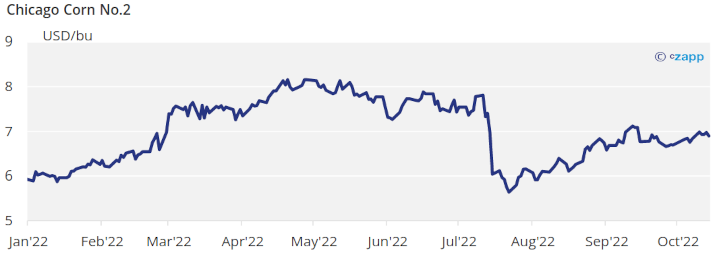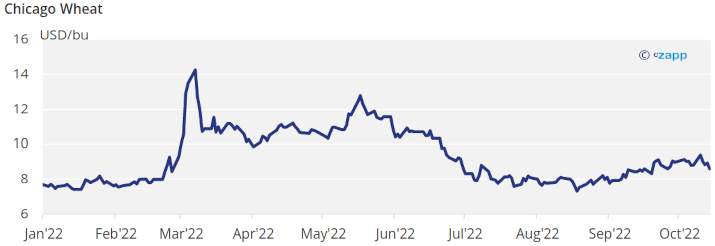Opinions Focus
- Officials met last week to discuss extending the Ukrainian export corridor.
- The current deal ends in November.
- Russia is signaling that they aren’t happy with the current deal.
Forecast
No changes to our average price forecast for the 22/23 (Sep/Aug) crop in a range of 5,8 to 6,3 USD/bu. The average price since Sep 1 is running at 6,8 USD/bu.
Market Commentary
Tensions in Ukraine sparked a rally in wheat but it corrected during the rest of the week with Russia expecting 105 mill ton of production – an all-time high. Corn consolidated gains closing around 1% higher week on week in all geographies. The October WASDE was within expectations.
Grains started strong last week as Russia bombed Kiev and other cities in Ukraine raising concerns the export corridor might be at risk. The reality is that weekly grains exports in Ukraine fell 8% week on week but this was before the bombing by Russia. Last Sunday officials met in Moscow to discuss the extension of the agreement for the export corridor which expires in November. At the time of writing there was no information of the outcome of that meeting but is true Russia has been giving signals they are not happy with the actual deal. We will have to wait and see.
The October WASE was published last week with a reduction in US Corn production both for the old crop 21/22 and the new crop 22/23. Overall new crop ending stock were reduced by 47 mill bu influenced by 148 mill bu of lower old crop ending stocks.

Old crop production fell by 42 mil bu and feed and residual demand increased by 115 mill bu with minor changes in Ethanol usage and exports. This resulted in 148 mill bu of lower ending stocks for the 21/22 crop.
New crop production was reduced by 49 mill bu all coming from yield revised down to 171,9 bpa vs. 172,5 before. On the demand side, Feed usage was increased by 50 mill bu, Ethanol usage was reduced by 50 mill bu and exports by 125 mill bu. Ending stocks fell by 47 mill bu taking stock to use ratio to 8,3% vs. 8,5% before.
Global Corn ending stocks were revised 3,3 mill ton lower in a combination of lower initial stocks (coming from the US), lower production but also lower demand. Only EU production was reduced by 2,6 mill ton to 56,2 mill ton more or less in line with the 55,7 mill ton of the EC forecast.
US Corn condition improved two percentual points to 54% good or excellent vs. 60% last year and is 31% harvested behind last year but in line with the five year average. French Corn condition remained stable at the all-time low level of 41% good or excellent and is 83% harvested vs. 14% last year. Summer Corn planting in Brazil has reached 27% vs. 29% last year.
In the Wheat front, and despite the initial rally, Russia is thinking of fully cancelling their export quota given the all-time high crop they are about to finish harvesting.

The October WASDE reduced US Wheat ending stocks by a sizable 34 mill bu. Initial stocks were increased by 9 mill bu, production was reduced by 133 mill bu with reductions in both area and yield. Feed demand was reduced by 30 mill bu and exports by 50 mill bu.
Global Wheat ending stocks were lowered by 1 mill ton almost all of it coming from lower initial stocks. Argentina’s production was lowered by 1,5 mill ton, EU was increased by 2,5 mill ton and surprisingly Russia was left with 91 mill ton of production when official data shows they have already harvested 103 mill ton which is a 36% yoy increase and this is 97,5% of the harvested are so the final production number should be around 105 mill ton.
US winter Wheat is 55% planted just three points below last year and the five year average. It has picked up from the delay it showed last week and again, we don’t consider the delay worrisome.
In the weather front, the US is expected to remain dry favoring field activity, both Corn harvesting and Wheat planting. In south America, dry weather persists in Argentina which will increase dryness in the soil thus delaying planting while in Brazil some rains are forecasted again and is leaving soil moisture very favorable. Europe is expected to receive some rains in the north west increasing soil moisture which will help winter Wheat development.
Besides all the fundamental data, low water in the Mississippi continues and concerns are raising around the export flow which has finally resulted in higher Corn basis in the Gulf Coast.
The fundamental picture continues to be tight, but something we don’t understand is why the USDA is not recognizing Russian Wheat data as there is some 12 mill ton difference between the USDA forecast and Russian stats. We think the market is pricing the 105 mill ton bumper Wheat crop in Russia.
But once more the focus in the short term will be around the export flow through the Black Sea and the extension of the actual export corridor. The result of yesterday’s meeting in Russia should give some light around the future of the corridor and probably some volatility. But tight global grains stocks should leave the market well supported with the major downside risk coming from the negative macro environment.












